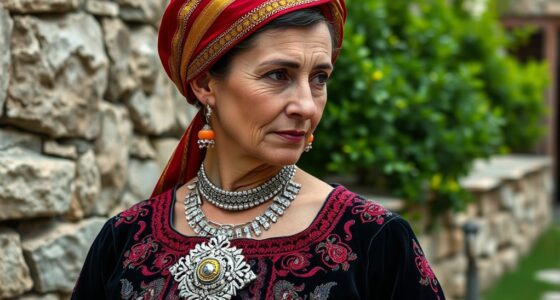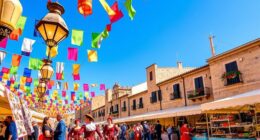Sardinian song lyrics reflect the island’s rich history, cultural identity, and social struggles, often expressing themes of land, community, and spirituality. You’ll notice the unique vocal styles like Cantu a Tenore, with different voices harmonizing to create powerful sounds that connect communities. These lyrics serve as oral traditions, capturing local life and resistance. If you continue exploring, you’ll uncover how these songs preserve Sardinian heritage and shape regional pride.
Key Takeaways
- Sardinian song lyrics are deeply connected to the island’s history, culture, and oral traditions, often conveying community identity and resilience.
- The *Cantu a Tenore* features four vocal roles—oghe, mesu oghe, contra, and bassu—that create layered harmonies with specific regional styles.
- Lyrics address themes like land, nature, social issues, emigration, and spirituality, serving as oral records of community struggles and values.
- They are primarily in regional dialects, blending archaic vocabulary with modern themes, often using poetic forms like muttos and improvised verses.
- Sardinian lyrics symbolize community bonds, celebrate local traditions, and reinforce cultural cohesion through collective singing and rituals.
Roots and Cultural Significance of Sardinian Lyrics

The roots of Sardinian song lyrics run deep in the island’s history and oral traditions. You’ll find that many lyrics originate from ancient or medieval poetry closely tied to local pastoral life and storytelling. During the 15th and 16th centuries, writers like Antòni Canu and Hieronimu Araolla helped develop these lyrics into written forms, highlighting Sardinian’s cultural importance. Historically, lyrics served as subtle communication tools, hiding revolutionary messages during times like the Inquisition. They often depict local life, countryside, and towns, reflecting a strongly localized worldview. Despite foreign influences fragmenting the language, Sardinian lyrics remained mutually intelligible, preserving cultural continuity. This linguistic resilience demonstrates the community’s dedication to maintaining their cultural identity through song. These songs act as living symbols of identity, connecting communities and reinforcing their unique heritage. Cultural preservation through song has been vital in maintaining Sardinian traditions amid external pressures and changing social landscapes.
The Structure and Voices of Cantu a Tenore
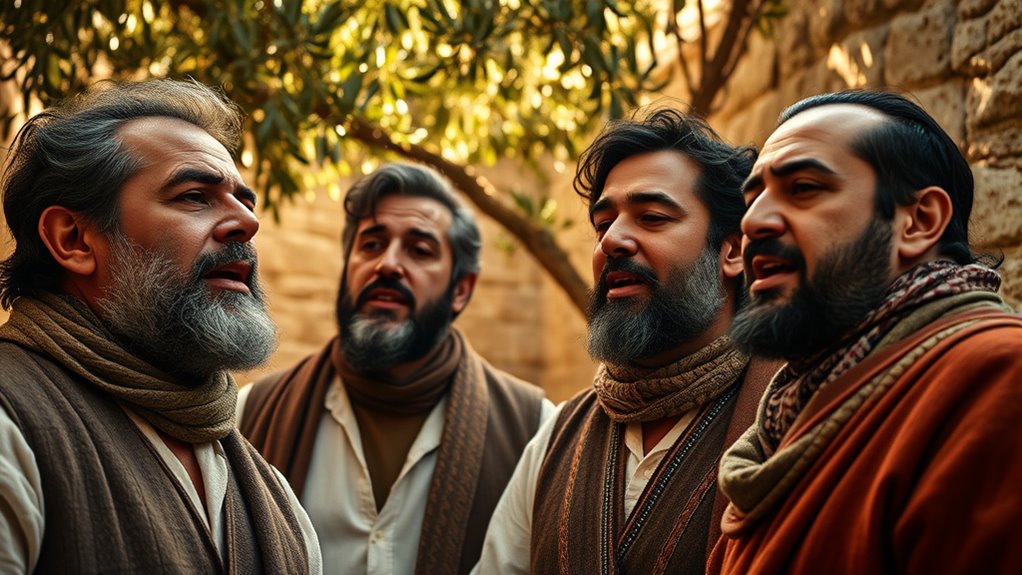
You can hear distinct vocal roles working together to create rich harmonies in Cantu a Tenore, with each singer contributing a unique sound. The *’oche* leads with poetic texts, while the other voices support with syllabic chorus and naturalistic imitations. Their interplay produces a complex, resonant sound rooted in precise tuning and harmonic balance. This polyphonic technique is characteristic of Sardinian pastoral traditions, emphasizing the importance of individual vocal roles within the ensemble. Additionally, vocal harmony reflects a deep cultural heritage that has been preserved through generations, showcasing the community’s musical identity.
Vocal Roles and Interplay
- The *oghe* initiates and guides the performance, setting the melodic and rhythmic foundation for the chant. It often leads with a clear, expressive voice that directs the flow of the song. Additionally, the *oghe* maintains the primary melody, ensuring coherence among the voices. This voice is crucial for conveying the emotional and spiritual essence of the piece, embodying the guiding spirit of the ritual or celebration.
- The *mesu oghe* adds melodic complexity, supporting the *oghe* with harmony and embellishments that enrich the overall sound. It provides intermediate harmonic voices that weave around the lead, creating a layered texture. This voice often responds to or echoes the *oghe*, enhancing the sense of dialogue within the ensemble. Its role is vital for maintaining the intricate interplay that characterizes the chant’s mystical quality.
- The *contra* harmonizes mainly a fifth above the *bassu*, contributing depth and earth-like resonance to the performance. It often engages in a call-and-response or dialogue with the *bassu*, emphasizing the primal elements of the tradition. The *contra*’s guttural tones evoke natural forces like fire and earth, grounding the performance in its sacred symbolism. Its robust sound creates a profound sense of spiritual connection with the natural world.
- The *bassu* anchors the ensemble with deep bass tones, providing a resonant foundation that supports the higher voices. It produces sustained, powerful vibrations that can be felt physically and spiritually. This voice embodies the elemental force of earth, reinforcing the chant’s symbolic connection to nature and cosmic balance. Its steady, profound presence ensures the stability and sacredness of the performance.
Harmonies and Tuning
Harmonies and tuning in *cantu a tenore* rely on precise interaction among four distinct voices, each tuned to specific intervals that create its characteristic sound. The *oghe* leads melodically, while the *bassu* usually sings the same note, and the *contra* a fifth above *bassu*. The *mesu oghe* fills middle harmonics, adding depth. The tuning often uses pentatonic or modal scales, differing from Western equal temperament, giving it a unique sonic flavor. Harmonies are flexible, varying between villages and performances, with voice entries after the solo *oghe* creating complex counterpoint. Singers stand close to facilitate tuning adjustments by ear, ensuring perfect blend. This spatial arrangement enhances the guttural sounds and the raw, earthy quality that defines *cantu a tenore*. Additionally, traditional tuning methods are essential for maintaining the authenticity and distinctiveness of this singing style.
Themes and Subjects in Song Content
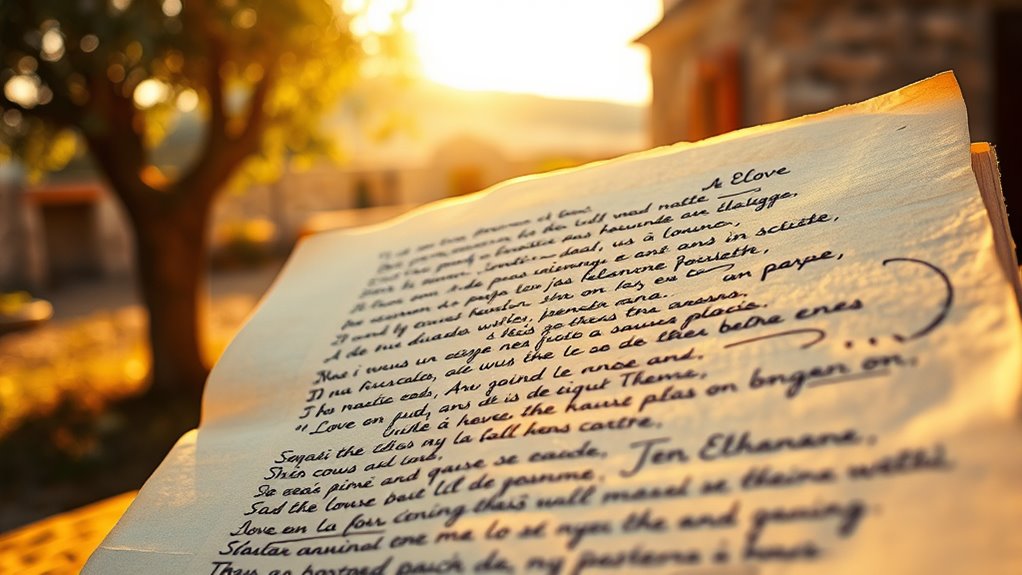
You’ll notice Sardinian songs reflect everyday life, from pastoral routines to rural traditions, capturing the island’s natural beauty and community bonds. They also confront social and political issues like oppression, emigration, and local struggles, often inspiring resistance and reform. Additionally, themes of faith and spirituality weave into the lyrics, highlighting the deep religious roots that shape Sardinian cultural identity. The use of essential oils in traditional practices exemplifies how sensory elements are integrated into cultural expressions, further enriching the lyrical storytelling.
Pastoral and Rural Life
Pastoral and rural life form the core themes of Sardinian song lyrics, vividly capturing the daily experiences and environment of shepherd communities. These songs reflect routine activities like herding, tending sheep, and seasonal cycles, offering a window into rural life. Environmental elements such as mountains, pastures, and the sea are frequent motifs, emphasizing the close bond between shepherds and nature. The songs highlight resilience amid hardships and celebrate the deep connection to land and animals. They also serve as oral records of local knowledge and pastoral techniques. To emphasize, these themes are:
- Depictions of daily rural activities and natural cycles
- Celebrations of resilience and land connection
- Preservation of local knowledge through poetry
- Reflection of environmental surroundings in song imagery
Additionally, the lyrics often incorporate references to traditional tools and techniques used in shepherding, helping to preserve cultural heritage.
Social and Political Issues
Social and political issues deeply shape Sardinian song lyrics, serving as powerful expressions of resistance, identity, and community solidarity. You’ll find songs recounting protests like the 1969 Pratobello rebellion, where locals opposed a NATO shooting range. Anthemic pieces like *Su patriotu sardu* originate from 18th-century calls against feudalism, now symbols of regional pride. Many bands highlight Sardinian independence, using music to assert cultural and political autonomy. Lyrics tell stories of rural communities fighting for land rights and resisting military or governmental control. Songs also address social justice, reflecting struggles with emigration, unemployment, and economic hardship. These themes connect local issues to broader anti-colonial movements, emphasizing how music becomes a voice for resistance, unity, and the preservation of Sardinian identity amid external pressures. Additionally, the political context of Sardinia influences the lyrical content, making music a vital tool for activism and cultural expression.
Religious and Sacred Themes
- Praise to saints, the Virgin Mary, and divine figures with solemn tones.
- Narration of Biblical events and local sacred histories, preserving oral tradition.
- Personal and community prayers seeking health, safety, and divine intervention.
- Blending Christian faith with older pastoral and nature symbols, reflecting Sardinia’s syncretic spirituality.
These themes reinforce shared beliefs and maintain spiritual continuity within the community’s cultural fabric.
Social Roles and Ritual Functions of the Songs
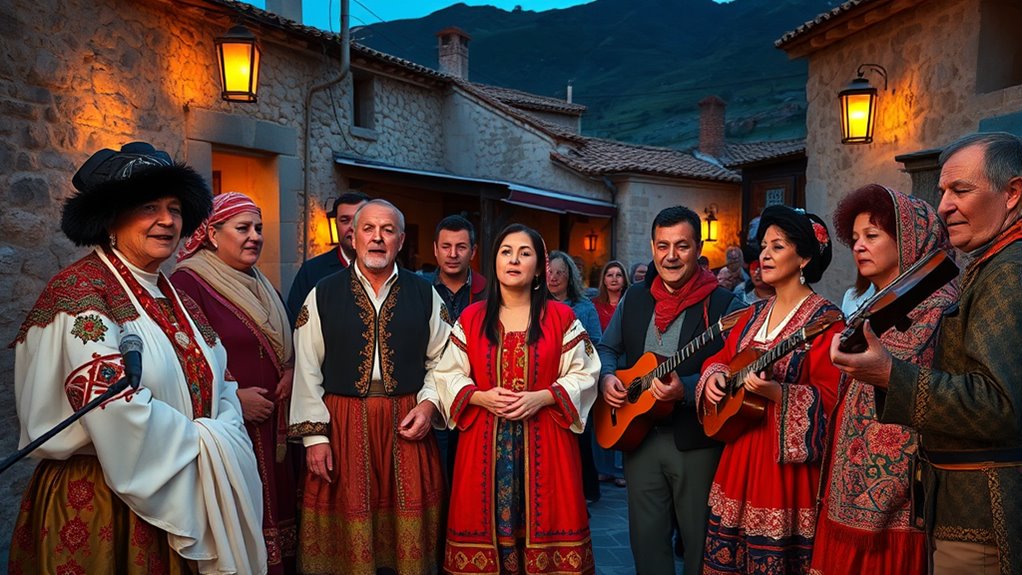
Sardinian songs, particularly the Canto a tenore, play a vital role in shaping community bonds and marking important life events. You’ll notice these songs are deeply rooted in Sardinia’s pastoral culture, performed mainly by men from central regions like Barbagia. Singing groups often represent their hometowns, strengthening local identity. They perform spontaneously in bars and at formal events, such as weddings and festivals. The four-voice harmony fosters community cohesion, symbolizing cooperation. Whether celebrating or marking solemn moments, these songs serve various ritual functions. They also carry social messages, addressing issues like emigration or political unrest. Here’s how their roles break down:
| Social Context | Ritual Occasion |
|---|---|
| Local identity | Weddings, religious festivals |
| Community bonding | Sheepshearings, carnivals |
| Social messaging | Poetic competitions, protests |
Language and Poetic Forms in Sardinian Music

Language and poetic forms are at the heart of Sardinian music, shaping how stories and emotions are conveyed through song. You’ll notice that lyrics are mainly in regional Sardinian dialects, especially from Barbagia and central Sardinia. They often use oral poetic forms that preserve archaic vocabulary and syntax, reflecting pastoral traditions. Here are key points to understand:
Sardinian music uses poetic forms and dialects to tell stories and express emotions.
- Sardinian lyrics blend ancient and modern themes, from love and pastoral life to social issues.
- Muttos, short rhythmic poems, are common in serenades and satirical songs.
- The Canto a Tenore tradition features improvised and fixed poetic structures, emphasizing expressive depth.
- Lyrics combine prose and sung poetry, creating a dynamic narrative and musical dialogue.
Furthermore, the poetic language often maintains a strong oral tradition that has been passed down through generations, ensuring the continuity of Sardinian cultural identity. This oral tradition plays a crucial role in preserving the unique dialects and poetic styles that define Sardinian music.
Preservation Challenges and Contemporary Adaptations

Traditional Sardinian song lyrics face significant challenges as social and economic changes reshape their original contexts. As pastoral lifestyles decline, the settings where these songs thrived fade away, weakening their transmission. Urbanization and tourism alter audiences and venues, risking the loss of authenticity. Younger generations are increasingly exposed to global languages and music, risking Sardinian linguistic and cultural displacement. Many lyrics remain only in local memory or informal knowledge, making them fragile. Meanwhile, commercial pressures lead artists to simplify or modify lyrics to appeal to broader audiences, diluting themes. Despite these obstacles, contemporary artists incorporate Sardinian elements into popular genres, use bilingual lyrics, and experiment with modern sounds. Community efforts, festivals, and digital archives help preserve and adapt these songs for future generations. Efforts to digitize and archive traditional songs are crucial in safeguarding Sardinian musical heritage for the digital age.
The Role of Lyrics in Community Identity

Lyrics serve as powerful symbols of community identity, capturing the values and social bonds that define Sardinian life. They reflect local culture, marking community boundaries and celebrating village uniqueness. Songs are integral to social and religious occasions, reinforcing shared traditions. The oral tradition guarantees these lyrics pass through generations, strengthening collective memory and cultural continuity. They also serve as markers of diversity, with regional variations highlighting local history and environment.
Key points:
- Lyrics embody core cultural values and social cohesion.
- They reinforce community boundaries and village identities.
- Singing during rituals fosters collective belonging.
- Variations highlight regional diversity and pride.
Notable Variations and Regional Styles

Sardinian vocal styles showcase remarkable regional diversity, with the Canto a Tenores standing out as the island’s most distinctive form. You’ll notice four male voices—boghe, bassu, contra, and mesa oghe—creating a powerful, layered sound. In central Sardinia, the deep, guttural bassu and contra voices reflect pastoral traditions, while northern regions like Gallura feature more lyrical, folk-ballad influences inspired by singers like Maria Carta. Songs vary from serenades to dance tunes, often performed in informal circles or at celebrations. Regional differences extend to instruments like the launeddas and dance styles, which emphasize community and ritual. Socio-economic shifts and tourism influence these styles, but traditional elements persist, especially in remote villages, maintaining Sardinia’s rich musical diversity. Understanding the importance of cultural heritage helps explain how these musical forms continue to thrive amid modern changes.
Frequently Asked Questions
How Do Sardinian Lyrics Influence Regional Identity Today?
You see that Sardinian lyrics shape regional identity by blending local dialects with Italian, fostering pride and a sense of belonging. Through traditional singing styles like *canto a tenore* and contemporary songs shared online, you can feel the community’s collective memory and social values. These lyrics, often performed at social events, reinforce cultural bonds, reflect social issues, and keep Sardinian heritage alive amid modern changes and challenges.
Are There Modern Themes in Sardinian Song Lyrics?
You notice how modern themes weave through Sardinian song lyrics, like a river flowing into familiar waters. Today’s songs address emigration, unemployment, and environmental change, blending traditional sounds with current issues. As you listen, you feel a connection to the land and people’s struggles, almost like hearing their stories sung aloud. These songs serve as living mirrors, capturing Sardinia’s evolving identity and shared resilience amid social and political shifts.
How Do Lyrics Compare Across Different Sardinian Regions?
You’ll notice that lyrics vary across Sardinian regions, reflecting local issues and cultural influences. Each area has its unique “moda,” with themes like emigration, social struggles, or pastoral life, shaped by regional history and traditions. Despite these differences, many regions use “Su Logudoresu” to maintain a common linguistic and poetic thread. This regional diversity enriches Sardinian music, giving each area a distinctive voice while preserving a shared cultural identity.
What Are Common Poetic Devices Used in Sardinian Lyrics?
Did you know that Sardinian songs often feature four vocal parts? You’ll notice poetic devices like polyphonic singing, call-and-response, and repetition, which make the lyrics more engaging. You’ll also see vivid imagery from nature and community life, along with dialect-rich language that adds cultural depth. These devices create emotional resonance, reinforce collective identity, and make Sardinian music vibrant and memorable, connecting tradition with modern themes seamlessly.
How Do Lyrics Function During Sardinian Festivals and Rituals?
During Sardinian festivals and rituals, you’ll find lyrics serving multiple roles. You sing them to express local pride, pass down traditions, and share community stories. They also act as subtle resistance, conveying social and political messages. As you perform, the lyrics strengthen bonds, mark important rites of passage, and connect you to your cultural heritage. Whether in dance, prayer, or celebration, these words keep your community’s identity alive and vibrant.
Conclusion
By exploring Sardinian song lyrics, you uncover a rich tapestry of history, culture, and community spirit. These songs aren’t just melodies; they’re the heartbeats of Sardinia’s identity, echoing traditions and stories passed down through generations. While challenges exist, embracing these musical forms keeps the flame alive. Remember, if you want to understand a place, you’ve got to listen to its songs—because they’re truly worth their weight in gold.





